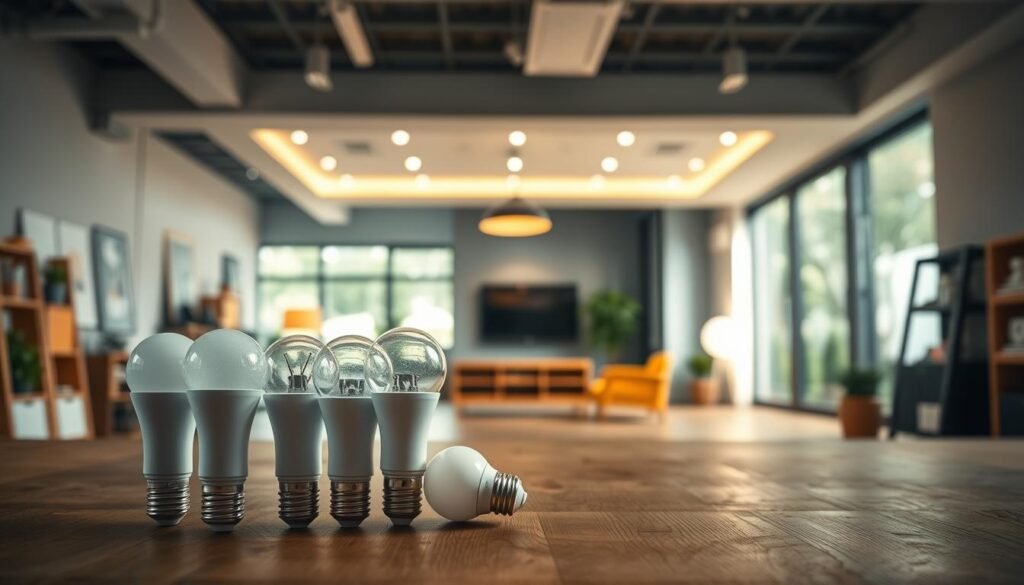Living in the city presents unique challenges for managing your home’s power usage. Smaller spaces and shared infrastructure create opportunities for smart efficiency improvements.
Simple behavioral changes and strategic upgrades can significantly lower your monthly electricity bills. You’ll discover that working smarter with resources doesn’t mean sacrificing comfort.
This guide explores practical strategies for urban dwellings. You’ll learn about lighting choices, appliance operation, and daily habits that impact your overall energy consumption.
The financial benefits are substantial. Small investments in efficiency yield long-term savings on utility costs while helping the environment.
Key Takeaways
- Urban living offers unique opportunities for energy efficiency in compact spaces
- Simple behavioral changes can dramatically lower your electricity bills
- Smart upgrades provide both immediate and long-term financial savings
- Energy efficiency enhances comfort without requiring lifestyle sacrifices
- Understanding your consumption patterns is the first step toward meaningful change
- Small investments in efficient appliances and systems pay off quickly
- Every room in your home presents different energy-saving opportunities
Understanding Your Home Energy Usage
Knowing where your power goes is the first step toward smarter management. Many city dwellers are surprised to learn which appliances and systems consume the most electricity.
Your monthly statement reflects usage from several key areas. Heating and cooling systems typically dominate, followed by water heating and major appliances.
Lighting also contributes significantly to your overall costs. Understanding these patterns helps you prioritize where to focus your efficiency efforts.
Where Your Electricity Bill Comes From
Seasonal changes dramatically affect your power needs. Winter months often show higher usage due to heating demands.
Summer brings increased cooling costs that spike your statement. These seasonal swings highlight opportunities for strategic adjustments.
Major appliances like refrigerators and washers account for substantial consumption. Their constant operation makes them significant contributors to your total usage.
Water heating represents another major expense area. Showers, laundry, and dishwashing all require heated water that adds up quickly.
The Impact of Phantom Power Consumption
Many devices secretly drain electricity even when turned off. This phantom power, often called vampire energy, occurs in standby mode.
Electronics with remote controls or digital clocks are common culprits. Chargers left plugged in and computers in sleep mode also contribute.
These energy vampires can add 5-10% to your total bill. That represents significant wasted money for no benefit.
Standby power from devices like entertainment systems and chargers can cost households up to $100 annually when left connected.
Smart power strips offer an effective solution to this problem. They automatically cut power to devices not in use, eliminating phantom drain.
Energy monitoring tools help identify which gadgets consume the most. Smart meters provide real-time data about your usage patterns.
Unplugging unused electronics makes an immediate difference. This simple habit prevents silent energy theft from your wallet.
How to Reduce Energy Consumption in Urban Households Through Lighting
Your lighting choices offer some of the easiest ways to cut your monthly expenses. Simple adjustments can create significant savings while maintaining comfort and functionality.

Maximize Natural Light During Daytime Hours
Open those curtains and blinds during daylight hours. This simple habit brightens your space without using any electricity.
Natural illumination provides passive solar heating in colder months. You’ll enjoy both light and warmth from the same source.
Switch to Energy-Efficient LED Bulbs
Modern LED technology uses 75-90% less power than old incandescent bulbs. They provide the same quality of illumination while lasting years longer.
The initial investment pays for itself through lower electricity bills. You’ll replace bulbs less frequently, saving both money and hassle.
“LED lighting typically pays for itself within one year through energy savings alone, making it one of the smartest home upgrades available.”
Install Timers for Exterior Lighting
Automated controls ensure outdoor lights only operate when needed. This prevents overnight energy waste from forgotten switches.
Some timer models connect to smart systems for phone or voice control. You gain convenience while eliminating unnecessary usage.
Motion sensors provide another excellent option for security lighting. They activate only when detecting movement, maximizing efficiency.
Consider task lighting instead of illuminating entire rooms. Focused light sources provide better visibility where you need it most.
Choose appropriate color temperatures for different activities. Warmer tones create comfort in living spaces, while cooler lights work better for tasks.
These strategies work together to lower your overall costs. You’ll notice the difference on your next statement.
Optimize Your Heating and Cooling Systems
Your climate control systems represent one of the largest contributors to your monthly utility expenses. Proper management of these systems can yield significant savings while maintaining your comfort.
Smart temperature regulation makes a noticeable difference in your power usage. These strategies work effectively in any urban dwelling.
Set Your Thermostat to Energy-Saving Temperatures
Adjusting your thermostat settings creates immediate savings. During colder months, set your heating to 68°F (20°C) for optimal efficiency.
Warmer seasons benefit from cooling settings between 75-78°F (24-26°C). Each degree adjustment saves approximately 3% on your heating and cooling costs.
These temperature ranges provide comfort while minimizing system strain. You’ll notice the difference on your monthly statements.
Use Programmable or Smart Thermostats
Modern thermostats automatically adjust temperatures based on your schedule. They learn your patterns and preferences for maximum efficiency.
Programmable models can save households up to $150 annually by optimizing temperature settings throughout the day.
Smart versions connect to your phone for remote control. They adjust settings when you’re away and prepare your home before you return.
Maintain Your System with Regular Filter Changes
Dirty air filters force your HVAC system to work harder. This increases energy consumption and reduces indoor air quality.
Regular maintenance keeps your system running efficiently. Monthly filter changes prevent energy waste and extend equipment life.
Clean filters improve airflow and system performance. They help maintain consistent temperatures throughout your home.
Supplement with Ceiling Fans for Better Air Circulation
Ceiling fans complement your AC system by improving air distribution. They create a wind-chill effect that makes rooms feel cooler.
This allows you to raise thermostat settings while maintaining comfort. Fans use significantly less electricity than air conditioning units.
Remember to reverse fan direction seasonally. Clockwise rotation in winter helps distribute warm air that rises to the ceiling.
These approaches work together to lower your overall energy costs. Your system operates more efficiently with proper support.
Upgrade Your Appliances and Electronics
Updating household gadgets can dramatically lower your monthly operating costs. Modern equipment offers superior performance while using significantly less power.
Strategic replacements pay for themselves through ongoing savings. You’ll enjoy better functionality while watching your utility expenses decrease.
Choose Energy-Efficient Models When Replacing Appliances
Look for Energy Star certification when shopping for new equipment. These models meet strict efficiency guidelines from the EPA.
Refrigerators and dryers typically consume the most electricity in urban homes. Modern efficient versions can use half the power of older units.
“Energy Star certified appliances use 10-50% less energy than standard models, providing immediate savings on your electricity bills.”
The initial investment pays back quickly through lower operating costs. You get the same functionality with substantially reduced electricity consumption.
Unplug Devices When Not in Use
Many electronics continue drawing power even when switched off. This phantom load secretly adds to your monthly expenses.
Chargers, computers, and entertainment systems are common culprits. Simply unplugging them eliminates this wasted electricity.
This habit takes seconds but makes a noticeable difference. You’ll prevent energy theft from devices sitting idle.
Use Smart Power Strips to Eliminate Standby Power
Smart strips automatically cut power to unused electronics. They detect when devices enter standby mode and disconnect them completely.
These tools can save households up to $45 annually. They handle the unplugging for you, making efficiency effortless.
Energy monitoring plugs help identify which gadgets consume the most. You gain valuable insights into your usage patterns.
Upgrading older electronics provides additional savings opportunities. Newer models often incorporate better power management features.
These strategies work together to maximize your efficiency gains. Your wallet and the environment both benefit from smarter choices.
Improve Your Home’s Efficiency Through Insulation
Your home’s insulation quality directly impacts how much power your heating and cooling systems require. Proper thermal barriers maintain comfortable temperatures with less energy input.
Many people discover that addressing insulation issues provides some of the most significant savings on their monthly bills. These improvements work year-round to protect against both summer heat and winter cold.
Seal Air Leaks Around Windows and Doors
Drafts force your climate control systems to work much harder than necessary. This increases overall energy consumption and raises your costs substantially.
Identify gaps around windows, doors, and other openings using simple detection methods. Feel for air movement or use incense sticks to reveal hidden leaks.
Caulk and weatherstripping materials create effective seals against unwanted air exchange. Proper sealing can save households up to $100 annually on energy costs.
Add Proper Insulation to Walls and Attics
Wall cavities and attic spaces benefit tremendously from adequate insulation. These areas account for significant heat transfer in most homes.
Different materials serve various applications throughout your house. Fiberglass batts work well in standard wall cavities while blown-in cellulose suits attic spaces perfectly.
Proper insulation in walls, attics, and crawl spaces can reduce heating and cooling costs by up to 30% according to energy efficiency experts.
Spray foam insulation provides excellent air sealing properties for tricky areas. Each material offers unique advantages for specific situations in urban homes.
Consider Double-Glazed Windows for Better Thermal Performance
Window upgrades represent a substantial improvement in thermal performance. Double-glazed units create an insulating air gap between glass panes.
This design significantly reduces heat transfer compared to single-pane windows. You’ll notice more stable indoor temperatures throughout seasonal changes.
These windows also reduce outside noise transmission for a quieter living environment. The combination of comfort and peace makes them valuable investments.
Don’t forget about insulating your water heater and pipes too. This simple step can save an additional $40 yearly by reducing heat loss.
Your improved thermal envelope means your systems work less while maintaining perfect comfort. The savings accumulate month after month on your utility bills.
Adopt Energy-Saving Daily Habits
Your everyday routines offer powerful opportunities to cut utility costs. Small adjustments to how you handle chores and personal care create meaningful savings.
These simple changes become second nature quickly. They add up to noticeable differences on your monthly statements.

Optimize Your Laundry and Dishwashing Routines
Always wait until you have full loads before running machines. This approach maximizes each cycle’s efficiency.
Cold water washing provides excellent cleaning while using less power. It also helps preserve your clothing’s colors and fabric quality.
Modern detergents work perfectly in cooler temperatures. You’ll get fresh laundry without the energy waste.
Dishwashers actually use less water than hand washing when fully loaded. Their energy-saving settings provide sparkling clean dishes efficiently.
Reduce Your Hot Water Usage
Shorter showers make a big impact on your water heating costs. Even one minute less per shower adds up over time.
Low-flow showerheads maintain pressure while using less water. They’re inexpensive upgrades that pay back quickly.
Fix leaky faucets promptly to prevent constant hot water waste. Dripping taps can waste gallons daily.
Families can save up to $70 annually simply by repairing leaky faucets and installing efficient showerheads.
These simple steps help reduce your overall energy needs. Your water heater won’t have to work as hard.
Practice Efficient Cooking Techniques
Always use lids on pots and pans when cooking. This traps heat and reduces cooking time significantly.
Match your pan size to the burner for maximum efficiency. Oversized burners waste heat around smaller cookware.
Your oven’s residual heat can finish cooking after you turn it off. This clever trick uses free energy.
Microwaves and toaster ovens use less power than full ovens for small meals. They’re perfect for quick tasks.
Pressure cookers dramatically reduce cooking times for many dishes. They’re energy-efficient tools for busy households.
These cooking tips save energy while delivering delicious results. You’ll notice the difference in your kitchen’s comfort level too.
Make energy conservation a family challenge. Track your progress together and celebrate your savings.
Turning off lights when leaving rooms becomes automatic with practice. Task lighting focuses illumination where you need it.
Every small habit contributes to your overall success. Your efforts will show on your next utility bill.
Conclusion
Your journey toward lower utility bills begins with simple, actionable steps that create real impact. Combining smart upgrades with daily mindfulness forms a powerful strategy for your home.
Small changes across lighting, appliances, and insulation deliver substantial cumulative savings. These improvements also benefit our planet by lowering carbon emissions.
Many efficiency upgrades qualify for local rebates or tax incentives. Consider a professional energy audit to identify your best opportunities.
Most households can achieve 20-30% lower power usage through these methods. You’ll enjoy enhanced comfort while watching your electricity costs decline.






